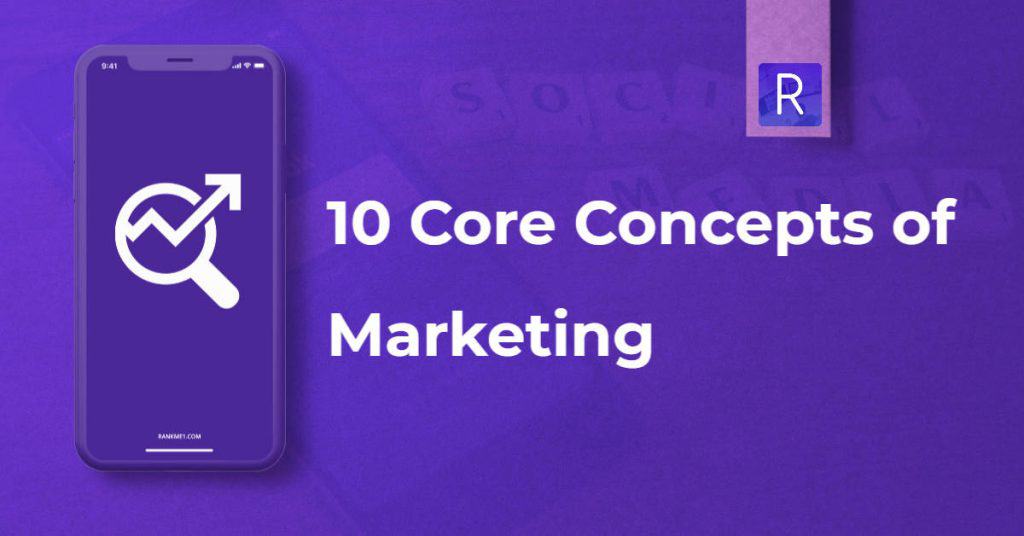Existence of unmet needs is precondition to undertake marketing activities. Marketing tries to satisfy needs of consumers. Human needs are the state of felt deprivation of some basic satisfaction. A need is the state of mind that reflects the lack-ness and restlessness situation. Needs are physiological in nature. People require food, shelter, clothing, esteem, belonging, and likewise.
Note that needs are not created. They are pre-existed in human being. Needs create physiological tension that can be released by consuming/using products. Marketing Management is a social and administrative procedure by which people or firms acquire what they need or need through making, offering, trading results of significant worth with one another. here are we listed some core concepts of marketing.
Here are Core Concepts of Marketing
-
Needs

Existence of unmet needs is precondition to undertake marketing activities. Marketing tries to satisfy needs of consumers. Human needs are the state of felt deprivation of some basic satisfaction. A need is the state of mind that reflects the lack-ness and restlessness situation.
Needs are physiological in nature. People require food, shelter, clothing, esteem, belonging, and likewise. Note that needs are not created. They are pre-existed in human being. Needs create physiological tension that can be released by consuming/using products.
-
Demand

Demand is the want for specific products that are backed by the ability and willingness (may be readiness) to buy them. It is always expressed in relation to time. All wants are not transmitted in demand. Such wants which are supported by ability and willingness to buy can turn as demand.
Marketer tries to influence demand by making the product attractive, affordable, and easily available. Marketing management concerns with managing quantum and timing of demand. Marketing management is called as demand management.
-
Wants

Wants are the options to satisfy a specific need. They are desire for specific satisfiers to meet specific need. For example, food is a need that can be satisfied by variety of ways, such as sweet, bread, rice, sapati, puff, etc. These options are known as wants. In fact, every need can be satisfied by using different options.
Maximum satisfaction of consumer need depends upon availability of better options. Needs are limited, but wants are many; for every need, there are many wants. Marketer can influence wants, not needs. He concentrates on creating and satisfying wants.
-
Utility (value), Cost, and Satisfaction

Utility means overall capacity of product to satisfy need and want. It is a guiding concept to choose the product. Every product has varying degree of utility. As per level of utility, products can be ranked from the most need-satisfying to the least need-satisfying. Utility is the consumer’s estimate of the product’s overall capacity to satisfy his/ her needs. Buyer purchases such a product, which has more utility. Utility is, thus, the strength of product to satisfy a particular need.
Cost means the price of product. It is an economic value of product. The charges a customer has to pay to avail certain services can be said as cost. The utility of product is compared with cost that he has to pay. He will select such a product that can offer more utility (value) for certain price. He tries to maximize value, that is, the utility of product per rupee.
-
Relationships and Network

Today’s marketing practice gives more importance to relation building. Marketing practice based on relation building can be said as relationship marketing. Relationship marketing is the practice of building long-term profitable or satisfying relations with key parties like customers, suppliers, distributors, and others in order to retain their long-term preference in business. A smart marketer tries to build up long-term, trusting, and ‘win-win’ relations with valued customers, distributors, and suppliers. Relationship marketing needs trust, commitment, cooperation, and high degree of understanding.
Advertisements:
Relationship marketing results into economical, technical, social, and cultural tie among the parties. Marketing manager is responsible for establishing and maintaining long-term relations with the parties involved in business.
Network is the ultimate outcome of relationship marketing. A marketing network consists of the company and its supporting stakeholders – customers, employees, suppliers, distributors, advertising agencies, colleges and universities, and others – whose role is considered to be essential for success of business. It is a permanent setup of relations with stakeholders. A good network of relationships with key stakeholders’ results into excelling the marketing performance over time.
-
Product

Product can also be referred as a bundle of satisfaction, physical and psychological both. Product includes core product (basic contents or utility), product-related features (color, branding, packaging, labeling, varieties, etc.), and product-related services (after-sales services, guarantee and warrantee, free home delivery, free repairing, and so on). So, tangible product is a package of services or benefits. Marketer should consider product benefits and services, instead of product itself.
Marketer can satisfy needs and wants of the target consumers by product. It can be broadly defined as anything that can be offered to someone to satisfy a need or want. Product includes both good and service. Normally, product is taken as tangible object, for example, pen, television set, bread, book, etc.
However, importance lies in service rendered by the product. People are not interested just owning or possessing products, but the services rendered by them. For examples, we do not buy a pen, but writing service. Similarly, we do not buy a car, but transportation service. Just owning product is not enough, the product must serve our needs and wants. Thus, physical product is just a vehicle or medium that offers services to us.
As per the definition, anything which can satisfy need and want can be a product. Thus, product may be in forms of physical object, person, idea, activity, or organization that can provide any kind of services that satisfy some needs or wants.
-
Exchange, Transaction, and Transfer

Exchange is in the center of marketing. Marketing management tries to arrive at the desired exchange. People can satisfy their needs and wants in one of the four ways – self-production, coercion/ snatching, begging, or exchanging. Marketing emerges only when people want to satisfy their needs and wants through exchange. Exchange is an act of obtaining a desired product from someone by offering something in return. Obtaining sweet by paying money is the example an exchange.
Exchange is possible when following five conditions are satisfied:
- There should be at least two parties
- Each party has something that might be of value to the other party
iii. Each party is capable of communication and delivery
- Each party is free to accept or reject the exchange offer
- Each party believes it is desirable to deal with the other party
Transaction differs from exchange:
Exchange is a process, not event. It implies that people are negotiating and moving toward the agreement. When an agreement is reached, it is transaction. Transaction is the decision arrived or commitment made. For example, Mr. X pays Rs. 25000 and obtains a computer. There are various types of transactions, such as barter transactions, monetary transactions, commercial transactions, employment transactions, civic transactions, religious or charity transactions.
Transaction involves following conditions:
- At least two things of value
- Agreed upon conditions
iii. A time of agreement
- A place of agreement
- A law (legal system) of contract to avoid distrust
Transfer involves obtaining something without any offer or offering anything without any return. For example, Mr. X gives gift to Mr. Y. Transfer is a one-way process. But pure transfer is hardly found in practice. One transfers something with some unexpressed expectations. Offer of money to beggar is to get the favor of God.
Donor gives donations and receives honor, appreciation, and special invitation, or even special influence in administration. Gift is rewarded in terms of gratitude, a good behavior, saying, “thank you” or with the expectation that the receiver of the gift will offer the same in the future. Almost all transfers are same as transactions. Transfer and transaction both are important for marketer.
-
Relationships and Network
Today’s marketing practice gives more importance to relation building. Marketing practice based on relation building can be said as relationship marketing.
Relationship marketing is the practice of building long-term profitable or satisfying relations with key parties like customers, suppliers, distributors, and others in order to retain their long-term preference in business.
A smart marketer tries to build up long-term, trusting, and ‘win-win’ relations with valued customers, distributors, and suppliers. Relationship marketing needs trust, commitment, cooperation, and high degree of understanding.
Relationship marketing results into economical, technical, social, and cultural tie among the parties. Marketing manager is responsible for establishing and maintaining long-term relations with the parties involved in business.
Network is the ultimate outcome of relationship marketing. A marketing network consists of the company and its supporting stakeholders – customers, employees, suppliers, distributors, advertising agencies, colleges and universities, and others – whose role is considered to be essential for success of
business. It is a permanent setup of relations with stakeholders. A good network of relationships with key stakeholders’ results into excelling the marketing performance over time.
-
Market

A market comprises of every single potential client sharing specific need/ need who might will and ready to take part in return to fulfill need/need.
Market Size = fn (Number of individuals who have need/need; have assets that premium others, willing or ready to offer these assets in return for what they need).
In Marketing terms: Sellers – called as “INDUSTRY”.
Purchasers – alluded to in a gathering as “MARKET”.
Sorts of Markets, Asset Market, Assembling Market, Delegate Market, Purchaser Market, Government advertise.
-
Marketers/Prospects
Working with business sectors to complete potential trades to fulfill needs and needs. One gathering looks for the trade all the more effectively, called as ” Marketer“, and the other party is designated “Prospect”. Prospect is somebody whom advertiser distinguishes as conceivably eager and ready to take part in return. Advertiser might be merchant or purchaser. The greater part of time, advertiser is vender. An advertiser is an organization serving a market even with rivalry.
Advertising Management happens when at any rate one gathering to a potential trade ponders the methods for accomplishing wanted reactions from different gatherings.


